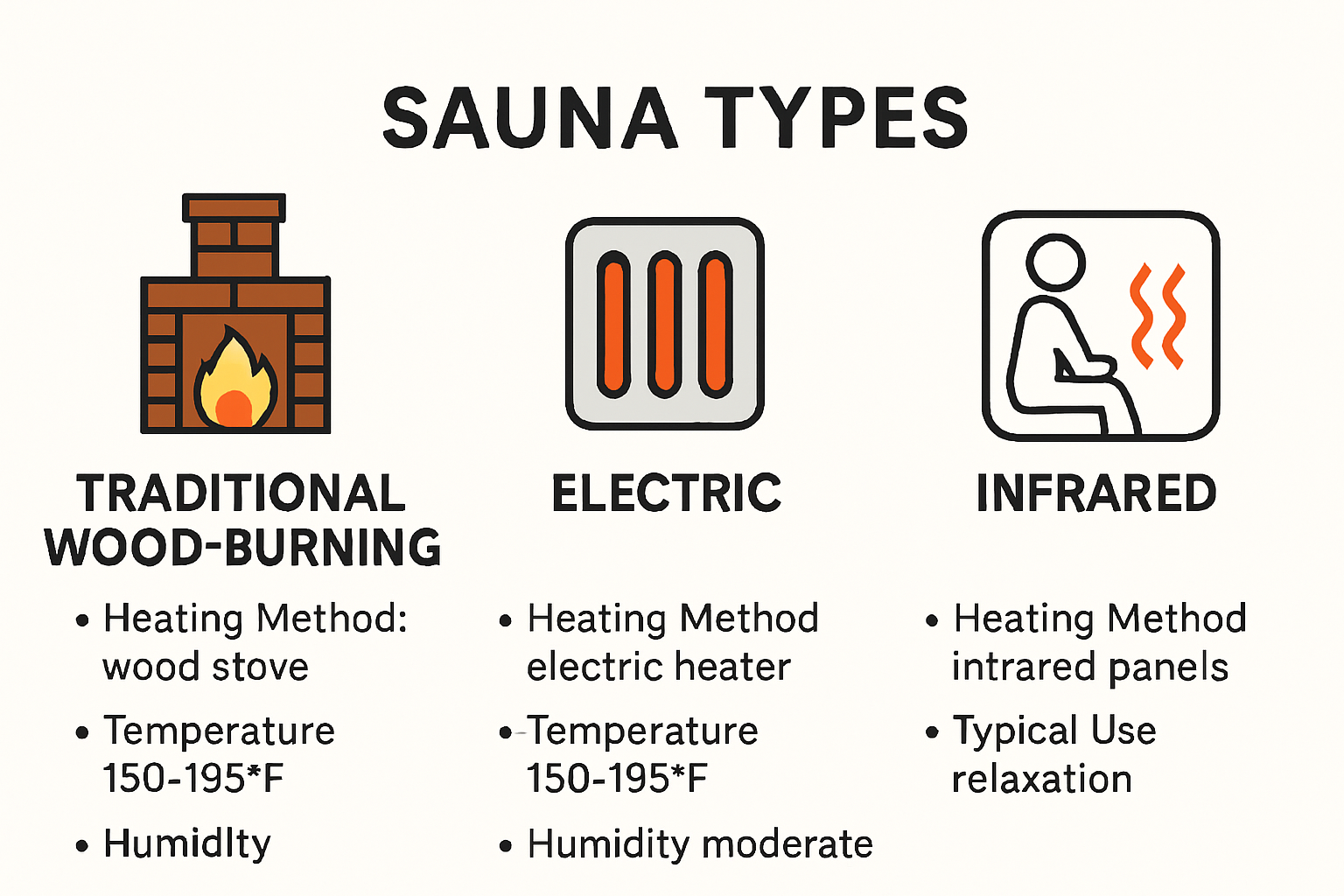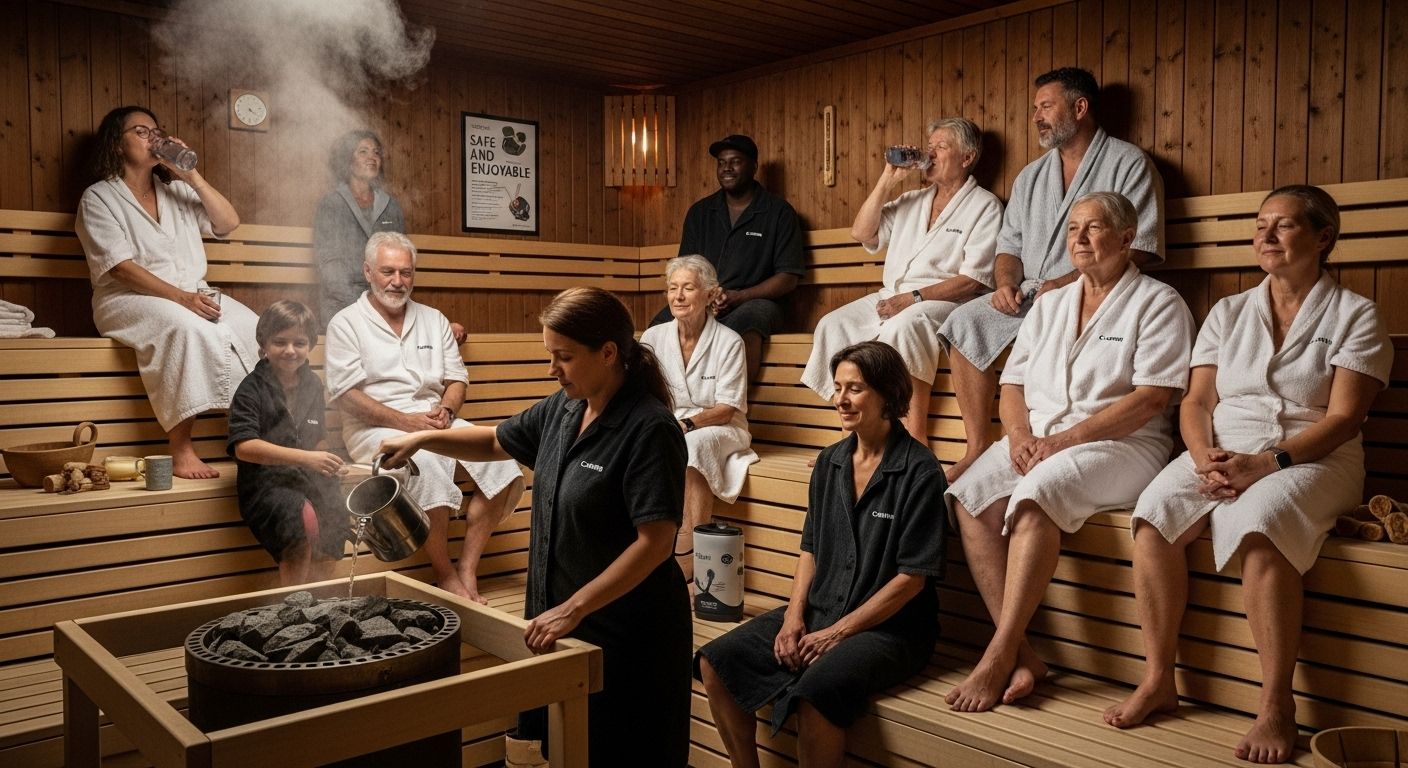
What to Expect in a Sauna: Guide for Wellness in 2025

Saunas seem simple at first glance. Step into a hot room, relax, and let the heat do the work. Surprising, right? While it sounds straightforward, the science behind regular sauna use is anything but basic. Studies show that just four sauna sessions a week can cut your risk of fatal heart events by up to 50 percent. Most people focus only on sweat and relaxation, but the real story is how following just a few proven habits in the sauna can supercharge both your mind and body in ways few expect.
Table of Contents
- Types Of Saunas And How They Work
- Health Benefits And Potential Risks
- Step-By-Step Sauna Experience Guide
- Tips For A Safe And Enjoyable Session
Quick Summary
| Takeaway | Explanation |
|---|---|
| Stay Hydrated Before and After | Drink water before, during, and after sauna sessions to prevent dehydration and support recovery. |
| Limit Session Times to 15-20 Minutes | To optimize safety and comfort, keep sauna sessions within the recommended time frame for better health benefits. |
| Consult a Doctor if You Have Health Issues | Individuals with cardiovascular conditions or other health concerns should seek medical advice prior to sauna use. |
| Start with Shorter Sessions | Beginners should initiate sauna use with 5-10 minute sessions, gradually increasing duration based on personal tolerance levels. |
| Monitor Body Signals During Use | Pay attention to physical cues like dizziness or discomfort, and exit the sauna immediately if these occur. |
Types of Saunas and How They Work
Understanding the diverse world of saunas involves exploring different heating technologies and design approaches. Each sauna type offers unique experiences and potential wellness benefits, catering to various preferences and health goals.
Below is a comparison table of the three main types of saunas discussed, summarizing their heating methods, typical temperature ranges, and unique benefits to aid in selecting the best option for your needs.
| Sauna Type | Heating Method | Typical Temp Range | Key Features/Benefits |
|---|---|---|---|
| Wood-Burning | Burning wood heats stones | High (often 70-100°C) | Authentic experience, intense heat, customizable humidity with steam, traditional feel |
| Electrically Heated | Electric heater warms stones | High (often 70-100°C) | Easy temperature control, fast warm-up, digital controls, easy installation |
| Infrared | Infrared light panels | Lower (usually 35-60°C) | Directly heats body, deeper tissue warming, lower ambient temp, good for beginners |
Traditional Wood-Burning Saunas
Traditional wood-burning saunas represent the oldest and most authentic sauna experience. Healthline describes these classic saunas as utilizing burning wood to heat stones and the surrounding room, creating an environment with low humidity and high temperatures. Typically constructed from high-quality wood like cedar or pine, these saunas generate heat through direct combustion, allowing users to experience a more intense and authentic thermal experience.
The heating process in wood-burning saunas involves carefully placed stones that absorb and radiate heat, creating a consistent temperature distribution. Users can enhance the experience by periodically pouring water over the heated stones, generating steam and increasing humidity. This practice, known as löyly in Finnish tradition, allows individuals to control the room’s atmospheric conditions and customize their sauna session.
Electrically Heated Saunas
Electrically heated saunas represent a modern evolution of traditional sauna technologies. Wikipedia explains that these saunas use electric heaters to warm the room and stones, providing a more convenient and controllable heating method. Unlike wood-burning alternatives, electric saunas offer precise temperature regulation and easier installation, making them popular in residential and commercial settings.
These saunas typically feature a dedicated electric heating element that quickly raises the room temperature to desired levels. The heating mechanism allows for rapid warm-up times and consistent heat distribution, ensuring a comfortable and efficient sauna experience. Electric saunas often include digital controls that enable users to set exact temperatures and session durations, enhancing user convenience and comfort.
Infrared Saunas: A Modern Wellness Approach
Infrared saunas represent a cutting-edge approach to thermal wellness. Mayo Clinic highlights that these saunas use light to directly heat the body, operating at lower temperatures compared to traditional saunas while still providing significant health benefits. This innovative technology distinguishes infrared saunas from conventional heating methods.
Unlike traditional saunas that heat the surrounding air, infrared saunas use electromagnetic radiation to penetrate the body directly. This approach allows for deeper tissue warming at lower ambient temperatures, making them more accessible for individuals who might find traditional high-heat environments uncomfortable. The targeted heating method can potentially promote improved circulation, muscle relaxation, and metabolic processes without subjecting users to extreme environmental temperatures.
Each sauna type offers a unique approach to thermal wellness, providing individuals with diverse options to explore personal health and relaxation strategies. Whether preferring the traditional wood-burning experience, the convenience of electric saunas, or the targeted approach of infrared technology, users can select a sauna that best matches their wellness objectives and personal preferences.

Health Benefits and Potential Risks
Sauna use represents a complex wellness practice with significant potential health advantages and important safety considerations. Understanding both the benefits and potential risks enables individuals to make informed decisions about incorporating sauna sessions into their wellness routines.
Cardiovascular and Physiological Benefits
Mayo Clinic Proceedings highlights groundbreaking research indicating that regular sauna bathing may substantially reduce risks associated with vascular diseases. The study reveals that consistent sauna use can improve endothelial function, reduce arterial stiffness, and positively modulate the autonomic nervous system. These physiological changes suggest potential long-term cardiovascular health improvements.
Research further demonstrates that sauna sessions induce mild hyperthermia, activating critical neuroendocrine and cytoprotective mechanisms. Mayo Clinic Proceedings suggests that this process might contribute to extended healthspan, potentially reducing overall morbidity and mortality risks. The thermal stress experienced during sauna use appears to trigger adaptive responses similar to those induced by moderate exercise, promoting cellular resilience and metabolic efficiency.
Potential Health Risks and Precautions
Harvard Health Publishing provides critical guidance regarding sauna use safety. While generally beneficial, certain individuals must exercise caution. People with uncontrolled high blood pressure, heart disease, or underlying cardiovascular conditions should consult healthcare professionals before incorporating sauna sessions into their wellness routine.
Significant risks emerge when basic safety protocols are overlooked. Experts recommend limiting individual sauna sessions to 15-20 minutes and avoiding alcohol consumption before or immediately after thermal exposure. Dehydration represents another potential concern, necessitating adequate fluid intake before, during, and after sauna use. Individuals with pre-existing medical conditions, pregnant women, and those taking medications that affect temperature regulation should seek medical advice prior to sauna engagement.
Holistic Wellness Considerations
Beyond immediate physiological responses, sauna use offers comprehensive wellness benefits. The combination of heat exposure, potential stress reduction, and mild cardiovascular stimulation creates a multifaceted approach to personal health management. Thermal therapy appears to support not just physical recovery but also mental relaxation, presenting a holistic wellness strategy.
While the potential advantages are compelling, individual responses to sauna use vary. Factors such as age, overall health status, fitness level, and personal tolerance significantly influence the experience. Gradual introduction, careful monitoring, and personalized approach remain key to safely experiencing sauna-related wellness benefits. Consulting healthcare professionals can help develop a tailored sauna strategy aligned with individual health objectives and physiological characteristics.
Step-by-Step Sauna Experience Guide
Navigating a sauna experience requires thoughtful preparation and understanding of best practices to maximize wellness benefits and ensure personal safety. This comprehensive guide provides essential insights for both first-time and experienced sauna users.
The following table summarizes the three main stages of a typical sauna experience, along with essential actions and recommendations for each phase to ensure a safe and effective session.
| Stage | Key Actions & Recommendations |
|---|---|
| Pre-Sauna Preparation | Hydrate, wear light clothing/bring towel, consult physician if needed, avoid heavy meals, eat light snack if desired, take warm shower |
| During Sauna Session | Start with 5-10 min (beginners), max 15-20 min, choose bench based on comfort, focus on breathing, exit if dizzy/unwell |
| Post-Sauna Recovery | Take cool/lukewarm shower, hydrate immediately, drink 2-4 glasses of water or electrolytes, allow gradual body temperature normalization |
Pre-Sauna Preparation
Healthline emphasizes the critical importance of pre-sauna preparation. Before entering a sauna, individuals should hydrate thoroughly by drinking water and wearing lightweight, comfortable clothing or bringing a clean towel to sit on. Those with pre-existing health conditions are strongly advised to consult their healthcare provider to determine sauna suitability.
Preparing your body involves more than just hydration. Experts recommend avoiding heavy meals immediately before sauna sessions, as digestion can interfere with the body’s thermal regulation. Light, easily digestible snacks consumed an hour before can help maintain energy levels without causing discomfort. Additionally, taking a warm shower before entering the sauna helps open pores and prepares the body for heat exposure, enhancing the overall experience.
During the Sauna Session
Cleveland Clinic provides critical guidance for safe and effective sauna use. Beginners should start with shorter sessions lasting 510 minutes, gradually increasing duration as personal tolerance develops. The recommended maximum session time is typically 1520 minutes, with careful attention to individual comfort and physical response.
Positioning within the sauna matters significantly. Lower bench areas offer slightly cooler temperatures, making them ideal for newcomers. Higher benches provide more intense heat, suitable for more experienced users. Sitting or lying down comfortably, users should focus on relaxed breathing and remain attentive to their body’s signals. If feeling dizzy, overheated, or uncomfortable, it is crucial to exit the sauna immediately and cool down.
Post-Sauna Recovery and Hydration
Harvard Health Publishing highlights the importance of proper cooling and hydration after sauna use. Immediately following the session, users should take a lukewarm or cool shower to help regulate body temperature. This gradual cooling prevents potential cardiovascular stress and supports the body’s natural temperature adjustment mechanisms.
Hydration represents a critical component of post-sauna recovery. Significant fluid loss occurs during thermal exposure, necessitating immediate and sustained water intake. Experts recommend drinking water before, during, and after the sauna session to replenish lost electrolytes and prevent dehydration. Some individuals might benefit from electrolyte-enhanced beverages to support comprehensive mineral replacement.
A successful sauna experience combines careful preparation, mindful participation, and thoughtful recovery. By understanding and respecting individual physical limits, users can transform sauna sessions into powerful wellness rituals. Listening to your body, maintaining proper hydration, and approaching the experience with patience and awareness are key to unlocking the full potential of thermal therapy.
Tips for a Safe and Enjoyable Session
Maximizing the benefits of sauna use requires more than simply entering a heated room. Strategic approaches to preparation, behavior, and recovery can transform a basic thermal experience into a powerful wellness ritual that supports overall health and personal comfort.
Optimal Session Strategy
SIU Medicine recommends a structured approach to sauna sessions. Ideal frequency involves four to seven 20-minute sessions weekly, with temperatures ranging between 80100 degrees Celsius. However, newcomers should adopt a gradual progression, starting with 510 minute sessions and incrementally increasing duration as personal tolerance develops.
Building sauna resilience requires patience and self-awareness. Initial sessions should focus on understanding personal heat tolerance and recognizing bodily signals. Positioning matters significantly strategies like sitting on lower benches for cooler temperatures or choosing higher benches for more intense heat can help manage thermal exposure. Listening to your body and maintaining comfort remain paramount throughout the experience.
Hydration and Physical Preparation
Cleveland Clinic emphasizes critical hydration protocols for safe sauna use. Drinking plenty of water or electrolyte beverages before, during, and after sessions helps maintain physiological balance. Individuals should aim to consume at least two to four glasses of cool water following each thermal exposure to replenish lost fluids and support metabolic recovery.
Pre-sauna physical preparation extends beyond hydration. Experts recommend avoiding heavy meals, alcohol, and medications that might interfere with temperature regulation. Light, easily digestible snacks consumed an hour before can provide energy without causing digestive discomfort. Taking a warm shower beforehand helps open pores and prepare the body for heat exposure, enhancing overall thermal adaptation.
Safety Monitoring and Warning Signs
Harvard Health Publishing highlights critical safety considerations for sauna use. Recognizing and responding to potential warning signs prevents health risks. Symptoms such as dizziness, weakness, rapid heartbeat, or difficulty breathing necessitate immediate sauna exit and potential medical consultation.
Certain populations require additional caution. Individuals with cardiovascular conditions, pregnant women, and those taking medications affecting temperature regulation should consult healthcare professionals before incorporating sauna sessions into their wellness routine. Some medical conditions might contraindicate sauna use or require modified approaches.
A successful sauna experience blends scientific understanding with personal intuition. By combining expert recommendations with individual body awareness, users can create a safe, enjoyable thermal wellness practice. The key lies in gradual adaptation, consistent hydration, and maintaining a mindful approach to personal health and comfort.

Frequently Asked Questions
What are the main types of saunas available?
There are three main types of saunas: traditional wood-burning saunas, electrically heated saunas, and infrared saunas. Each type offers unique heating methods and temperature ranges, catering to different preferences and wellness goals.
What are the health benefits of using a sauna?
Regular sauna use can provide numerous health benefits, including improved cardiovascular health, reduced risk of heart disease, enhanced muscle relaxation, and decreased stress levels. Studies suggest that sauna sessions can also improve endurance and overall well-being.
How long should I stay in a sauna during each session?
For optimal safety and health benefits, it is recommended to limit sauna sessions to 15-20 minutes. Beginners should start with shorter sessions of around 5-10 minutes and gradually increase the duration as their comfort level improves.
What precautions should I take before using a sauna?
Before using a sauna, ensure you are well-hydrated, avoid heavy meals, and consider consulting a healthcare professional if you have pre-existing health conditions. It’s also important to start with shorter sessions to gauge your body’s response to the heat.
Ready to Experience the True Power of Saunas at Home?
If you read through our sauna guide, you already know how crucial it is to maximize health benefits while keeping safety and comfort at the forefront. Maybe you want to boost your cardiovascular health, improve your skin, or simply melt away stress, but you worry about finding a sauna that fits your goals and delivers lasting results. The biggest question is how to bring those proven sauna habits from the article into your own daily routine.

The answer is at your fingertips. Discover a curated selection of premium infrared, traditional, and outdoor saunas along with essential wellness accessories at Best Life Sauna. Start a new wellness ritual with the right tools tailored to your needs. Visit Best Life Sauna today and transform your health journey. Explore our latest collection and embrace a safer, smarter way to sauna—your optimal wellness can’t wait.

